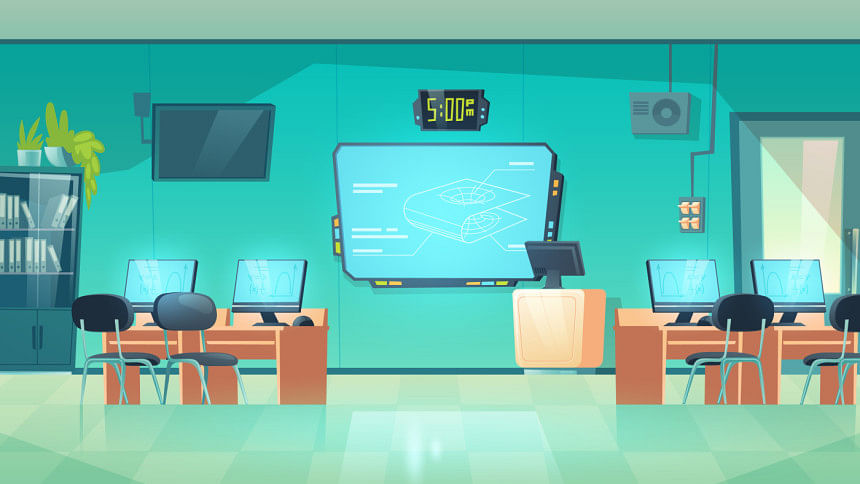Technology should assist in teaching, not dominate it

A decade ago, I attended a conference in Delhi focused on technology-driven education. As I listened to the keynote speakers, I noticed a common thread in their presentations: most of them sounded like enthusiastic promoters of educational technology, almost like evangelists. Some seemed like representatives of multinational companies, advocating the use of specific tools and platforms. They spoke in glowing terms about how technology would transform education for the better, but their repetitive rhetoric made the audience visibly bored.
Amidst this stream of tech-positivity, a chemistry professor from IIT Delhi broke the flow with a bold, contrarian view. He challenged the prevailing narrative. At first, his comments drew laughter, perhaps because they seemed outdated. But as he continued, the room quieted as his message gradually appeared to be thought-provoking. He firmly argued that using technology beyond chalk and board in classrooms was a mistake. According to him, technology was making teachers lazy and eroding their creativity. Many teachers were downloading PowerPoint slides and using them in class without preparation or explanation, resulting in students struggling to follow along. He urged educators to abandon this tech-driven approach, which he believed was leading education down the wrong path. Anything that destroys a teacher's creativity, he said, should have no place in the classroom.
At the time, I partially agreed with him, based on my own classroom experiences. But like many, I moved on, caught up in the daily pressures of academic life. Recently, however, an encounter brought his words back to me with renewed clarity. One day, I visited a friend's house and found his daughter watching a lecture by a foreign professor on her mobile phone using the loudspeaker. The video ended quickly. Out of curiosity, I asked, "Is your college closed today?" She replied, surprised, "No, it's open." I then asked why she skipped class. Her answer struck a chord: "I don't enjoy the lectures." When I probed further, she said, "The teacher just runs slides without any explanation. It's hard to concentrate. I feel completely disconnected in class."
Her words reminded me of that IIT professor's powerful observation: technology, if misused, can make teaching monotonous and ineffective. Students lose interest when educators rely solely on downloaded slides. It becomes harder for them to stay engaged, and over time, they drift away from learning. That professor's insights were not mere opinions—they now reflect a growing reality. Today's students are tech-savvy, but they are still human. They respond best to teachers who connect with them personally—teachers who explain face-to-face, who make classrooms feel alive. Slides and videos can never replace that connection. Education is not just about transferring information; it is about fostering understanding, inspiring curiosity, and encouraging critical thinking through interaction.
I am not suggesting a complete ban on technology in the classroom. That would be impractical and counterproductive. Rather, I strongly advocate for the careful use of technology—tools that complement, not replace, human interaction. Technology should assist in teaching, not dominate it. Teachers should not become slaves to screens. Instead, they should use technology to enhance their teaching and make learning more human-centred and engaging.
In recent years, the Government of Bangladesh has introduced various initiatives to promote the use of technology in education. Many schools and colleges have been equipped with digital infrastructure. But despite these efforts, no comprehensive evaluation has been conducted to assess the effectiveness of these technologies in improving educational quality. Consequently, we do not yet know whether this increased use of technology is having a truly positive impact. Moreover, as class time has become more constrained, a growing number of students are turning to private coaching centres. Despite government attempts to regulate this "coaching industry", these efforts have not been entirely successful. In reality, wherever there is demand, a market will emerge—that's the basic law of economics. The pressing question remains: why are students opting out of classrooms and going to coaching centres? Few have seriously investigated this fundamental issue. Until we conduct a deep analysis, we won't be able to solve the root problem.
At the college level, student participation in classroom learning is visibly declining. Even those who attend class are often not mentally engaged. Some may ask, "Aren't these students studying?" Of course they are—but mostly through private coaching or tuition. This raises another question: are classroom teachers not teaching effectively? Or are they unable to make their lessons engaging enough for students?
To answer these questions, we must think differently. In today's world, almost every student owns a smartphone and knows how to use it efficiently. Teachers, too, are now digitally equipped. If we stop seeing this reality as a weakness and instead use it as a strength, might we bring about a positive transformation in our college classrooms?
This brings us to a modern and promising concept—the "flipped classroom." A flipped classroom turns the traditional model of instruction on its head. Instead of introducing new material in class, the teacher shares it with students beforehand via WhatsApp, Messenger, or other platforms. Students study the material at home and come to class with questions and thoughts. The classroom then becomes a lively space for discussion, clarification, and deeper engagement. This model isn't limited to printed material. Teachers can record brief video lectures and share them in advance. If these videos are interesting and aligned with the subject matter, they can boost student interest. Some teachers may even create their own YouTube channels and upload content for broader access. In addition, PowerPoint slides and other resources can be shared to support learning. These methods foster a culture of self-study and independence among students. Instead of memorising facts, they begin to understand concepts, think critically, and engage meaningfully with the material. As a result, they are more likely to participate actively in class, making the classroom a dynamic and interactive learning environment for both students and teachers.
In short, the flipped classroom can be an effective way to bridge the growing gap between students and teachers in this digital age. With just a little effort, it is possible to rekindle students' interest in learning and significantly increase their classroom engagement. It's not about rejecting technology, but about using it wisely and purposefully to enrich the educational experience.
Let us not forget: education is not merely about data delivery—it's about connection, communication, and transformation. A teacher's role is not just to provide information but to guide, inspire, and spark curiosity. As we move forward in this technology-driven era, let us strive to make our classrooms not silent, but vibrant—with dialogue, understanding, and mutual respect at the heart of every lesson.
Dr Md. Mizanoor Rahman is assistant professor at the Bangladesh Open University. He can be reached at [email protected].
Views expressed in this article are the author's own.
Follow The Daily Star Opinion on Facebook for the latest opinions, commentaries and analyses by experts and professionals. To contribute your article or letter to The Daily Star Opinion, see our guidelines for submission.

 For all latest news, follow The Daily Star's Google News channel.
For all latest news, follow The Daily Star's Google News channel. 





Comments